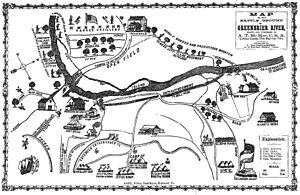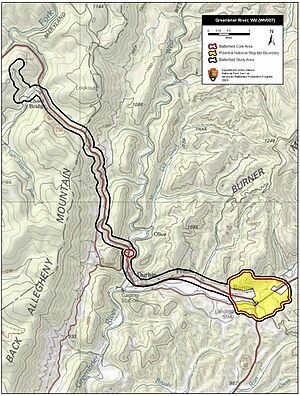Battle of Greenbrier River facts for kids
Quick facts for kids Battle of Greenbrier River(Battle of Camp Bartow) |
|||||||
|---|---|---|---|---|---|---|---|
| Part of the American Civil War | |||||||
|
|||||||
| Belligerents | |||||||
| Commanders and leaders | |||||||
| Brig. Gen. Joseph J. Reynolds | Brig. Gen. Henry R. Jackson | ||||||
| Strength | |||||||
| 5,000 | 1,800 | ||||||
| Casualties and losses | |||||||
| 8 killed 35 wounded |
6 killed 33 wounded 13 missing |
||||||
The Battle of Greenbrier River, also known as the Battle of Camp Bartow, was a fight during the American Civil War. It happened on October 3, 1861, in an area that was then part of Virginia but is now West Virginia. This battle was part of a larger plan called the Operations in Western Virginia Campaign.
Contents
Why the Battle Happened
Confederate Camp Bartow
In September 1861, Confederate soldiers set up a camp called Camp Bartow. It was in the Cheat Mountain area. General William B. Taliaferro led these Confederate troops. They knew the land well, which was a big advantage. However, many of his soldiers were sick, which made their army much smaller. General Taliaferro reported that only about one-third of his army was healthy enough to fight.
Union Plans and Weather
The Union forces in Cheat Mountain were led by General Joseph J. Reynolds. His army felt confident because they had recently pushed back General William W. Loring's troops. General Reynolds believed he could defeat the Confederates at Camp Bartow. He hoped this would clear a path through the mountains into Virginia.
Before the battle, it rained non-stop for two days. The cold weather caused both armies to lose soldiers. The harsh conditions made it tough for everyone involved.
Who Fought in the Battle
Union Army Forces
General Reynolds had about 5,000 soldiers. His army included different types of fighters. There were infantry (foot soldiers), cavalry (soldiers on horseback), and artillery (soldiers who use cannons).
Some of the units in his army were:
- The 24th, 25th, and 32nd Ohio Infantry.
- The 7th, 9th, 13th, 14th, 15th, and 17th Indiana Infantry.
- Artillery units like the 4th U.S. Light Artillery, Battery G, and Loomis' Michigan Battery.
- Cavalry units like Robinson's Ohio Cavalry and Brackens' Indiana Rangers.
Confederate Army Forces
The Confederate army was led by General Henry R. Jackson. His forces were smaller, with about 1,800 men.
His army included:
- The 1st and 12th Georgia Infantry.
- The 23rd, 44th, and a battalion of the 25th Virginia Infantry.
- The 3rd Arkansas Infantry and the 31st Virginia Infantry.
- Artillery units like Anderson's and Shumaker's Batteries.
- A part of the Churchville Cavalry.
- About nine miles away, Colonel John B. Baldwin was stationed with the 52nd Virginia Infantry.
The Battle of Greenbrier River
General Reynolds' Union troops started moving at midnight on October 2, 1861. By daylight, they had reached Greenbrier, which was about four miles from the Confederate camp.
At 8 o’clock in the morning, the Confederate soldiers guarding their camp left their posts. This allowed the Union soldiers to enter the Confederate camp. When the Union army started firing, the Confederate soldiers had trouble with their weapons. They were forced to move out into the open because of the Union's strong firepower.
Colonel John B. Baldwin, who was in charge of the 52nd Virginia Infantry, heard the gunshots. He immediately took all his men and rushed to help the Confederates. When they arrived, they thought they were too late. However, when the Union army saw more Confederate soldiers coming, they kept firing. The battle continued for about five more hours. Finally, General Reynolds ordered his troops to go back to Cheat Mountain, ending the fight.
What Happened After the Battle
After the battle, both sides realized that not many soldiers had been lost. To make themselves look better, both the Union and the Confederates claimed the other side had lost around 300 men.
When the real numbers were counted:
- The Union army had 8 men killed and 35 men wounded.
- The Confederate army had 6 men killed, 33 wounded, and 13 men missing.
Because neither side won a clear victory, the Battle of Greenbrier River was considered inconclusive. This means it ended without a definite winner.
Protecting the Battlefield
Efforts have been made to protect the land where the battle took place.
- The Staunton-Parkersburg Turnpike Alliance received money to create a plan to preserve the Greenbrier River/Camp Bartow site. They want to get community support for this plan.
- In 2016, the West Virginia Land Trust, working with the American Battlefield Trust, bought 14 acres of land. This land is a key part of the battlefield. The organization plans to make the site open to the public in 2018.



